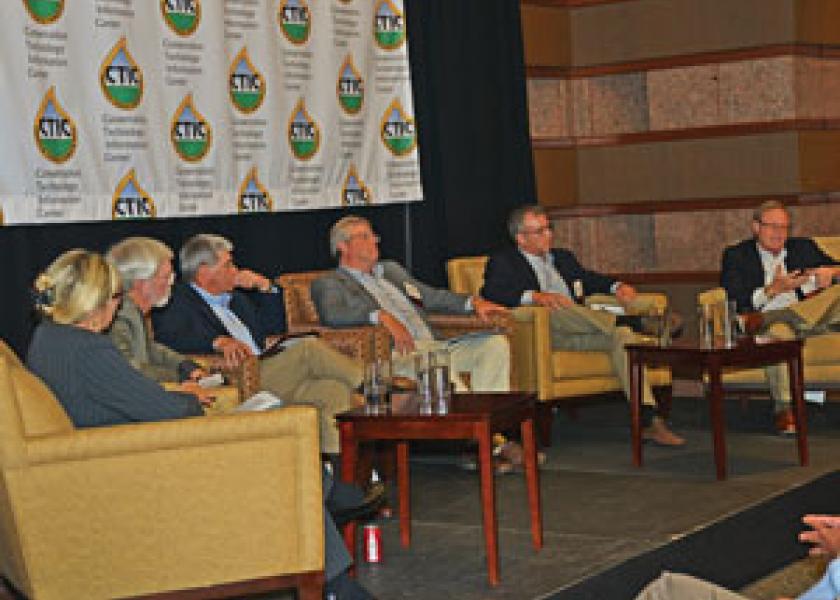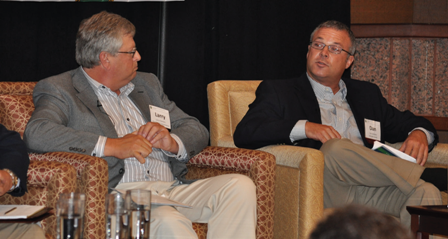Spotlight on Soil Biology

CTIC celebrates conservation—and looks to the future
The Conservation Technology Information Center (CTIC) had reason to celebrate 30 years of success this fall. Founded in 1982, the Lafayette, Ind.–based organization has created a working model of how to bring like and disparate interests together to achieve common conservation goals.
With two panels of experts in a forum setting, there was no preaching to the choir—just a turning of ideas on the roasting spit to check for doneness or more marinating time.
According to the "Future of Conservation" panel, the most pressing topic, trumping the latest technology challenges, is plain old soil biology.
Grain crop and cattle farmer Dan DeSutter of Attica, Ind., said farmers are coming to grips with organic matter and how it’s produced. "This will be what moves us forward in terms of our productivity," he said. When you focus on organic matter as your metric, you can put real value to it, he added.
"In 18 years of no-till corn and beans, we were able to double our organic matter back up to 4%," DeSutter said. "Why is this important? How are we going to get mainstream farmers to accept this as a goal? We know that for every 1% of organic matter in the top 12", there’s 1,000 lb. of nitrogen (N). In a typical year, we mineralize 2% to 4% of that."
He noted that at 3% organic matter with current nitrogen prices (UAN, for example) that comes to $40 to $50 per acre. "That extra 2% of organic matter allows us to store an extra 32,000 gal. of water per acre, which is the equivalent of 1¼" of rain."
Jerry Hatfield, director of USDA–Agricultural Research Service in Ames, Iowa, agrees. "The simple fact is that if our soils don’t absorb and retain water, the result will be food insecurity. If you look around the world, we’re still on a degradation slope in terms of the soil," he said. He emphasized the need to reverse this broad and damaging trend on a global basis.
"Unfortunately, we can’t just take the very successful North American system and do a layover on a developing country, but we can teach certain key things relating to soil health," said Jim Moseley, former USDA deputy secretary.
He added that we still have a way to go in our own country. "In the U.S. government we talk about air quality and we talk about water quality, but we don’t talk about soil quality. The interesting thing is, water and air quality are enhanced by a standard definition [of soil quality]."
Hatfield said we think about soil in a mechanical way to achieve soil structure and we treat soil chemically to achieve certain goals, but we don’t talk about biology doing all of the work for us. Referring to soil microbes, he said that most farmers don’t recognize the "livestock" they have living under their fields just outside their farm kitchen door. "Every morning, we should be waking up thinking about how we’re going to feed the elephants!" he joked.
Focus on what’s happening, biologically speaking, in the fence row, Hatfield encouraged. In Iowa, that would mean a piece of ground with 4% organic matter. "This year, we have harvested yields out of a simulated fence row of 290 bu.," he said. "That tells you what you can do when you think about a high-organic-matter soil with lots of water-holding capacity and lots of nutrients. If you can do 290 bu. per acre in a year like this, think what you can do in a good year!"
 |
Larry Clemens of The Nature Conservancy (left) and farmer Dan DeSutter banter about how often a farmer is asked about organic matter percentages. |
The next big thing. "There are a lot of undiscovered secrets of the soil that we’d better start figuring out because we don’t have 6" of soil distributed evenly around the world," Hatfield said. To illustrate the importance of doing the right kind of research, Hatfield shared a story about Illinois no-till pioneer Jim Kinsella.
"He asked me, Why are you doing ‘me-too’ research? He said, All you guys are studying is how our [no-till] system works. We already know it works! We need you studying the next thing we haven’t thought about."
When asked what they would like to see in the new farm bill, panelists said one popular idea is conservation compliance that is tied to crop insurance. "Right now, crop insurance is what drives a lot of decisions on the farm," DeSutter said. "This allows big farmers to bid ‘X’ [dollars] for land, knowing they’ve got this on the back side [insurance]."
If legislators are going to do something with insurance, he would like to see crop insurance and incentives such as the Conservation Stewardship Program, but without the bureaucracy.
To give an idea of the work ahead for CTIC and its partners, Moseley asked some pointed questions that might well have been asked since the inception of the Soil Conservation Service in 1935: "How do we get conservation accomplished with farmers at the ground level? Do we have anything new to say?"
Moseley talked about Landcare Australia, a successful public/private/ government partnership. "They put environment conservation at the center of Australian society," he said. "It isn’t just about the farmers and ranchers on their paddocks—83% of the Australian population knows about Landcare. We need to elevate the conversation here in a way we simply haven’t accomplished yet."
DeSutter gave a simple summary: "If you’re a farmer and you own land, you should be receptive to this argument: Why is some Iowa farmland worth $12,000 an acre and in southern Indiana, land is worth only $6,000? It’s basically organic matter."
Learn what other CTIC panelists had to say about the past and future of agriculture at www.FarmJournal.com/CTIC
You can e-mail John Buckner at jbuckner@farmjournal.com.







